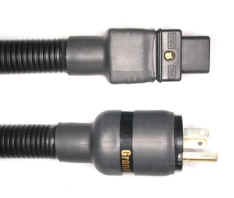|
You are reading the older HTML site
Positive Feedback ISSUE 7
empirical audio Grand Slam power cord as reviewed by Ed Morawski
|
||
|
|
I have never been a proponent of expensive power cords. Sure, the OEM ones are pretty marginal, as I feel the conductors should be at least 14-gauge AWG to guarantee good power transfer, but going beyond that has always seemed overkill, so when I was asked to review Empirical Audio's new Grand Slam cord, I told everyone concerned, "I have never heard an improvement with any power cord, so the Grand Slam has a lot to prove. They told me to go ahead, and let the chips fall where they may. Okay! I currently use a mixture of DIY 10-gauge power cords and a few purchased ones. The purchased ones are professionally done, but use the same components as my do-it-yourself cords. I've never had any complaints—they do their job. I have tried 14-gauge, 12-gauge, 10-gauge, shielded, non-shielded, braided shield, copper conductors, aluminum conductors, even CAT 5, without hearing any lasting or easily recognizable improvement. (Okay, when I went from the stock Plinius 16-gauge cord to my 10-gauge one, I did hear a slight increase in bass, but that was obviously the power supply opening up with increased current flow.) When the Grand Slam arrived, I was intrigued enough to study it. It is well made, with gold-plated prongs and a neat plastic jacket. Like all of Empirical's cables, it uses their Bare Wire Technology, and even comes with specifications and test results. I decided to conduct a logical, organized test by limiting my listening to just three components: my Plinius SA-102 power amp, E.A.R. 864 preamp, and Accuphase DP-65V CD player. I made sure that all three had the same 14-gauge purchased power cords so that I would have a proper baseline for comparison. Music consisted of two CDs—Madonna's American Life and Alison Krauss' So Long, So Wrong. I felt that this would be as close to a controlled experiment as possible in my home environment. Having already heard American Life a dozen or so times, I made note of a few issues that got my attention. On track 7, there seemed to be a great deal of sibilance, but the disc is otherwise quite good, with Madonna's usual stellar production and engineering and an extreme wide soundstage. This CD is very listenable, keeping in mind that everything is synthetic. The opposite situation exists with the Krauss disc, that is all acoustic and exhibits even better engineering. I figured that these two extreme cases would surely test the Grand Slam, and any improvement would be evident. When everything was warmed up and ready to go, I replaced the power cord to the Plinius SA-102 with the Grand Slam and sat back, expecting to be completely unimpressed. I started with track 7 on American Life, and lo and behold, most of the sibilance was gone! I was still in disbelief when track 8 started and deep bass notes revealed themselves. I had heard nothing like these before. It was quite startling. Unwilling to believe what I was hearing, I put my old cord back and listened again. Yep, the "sssss" in Madonna's voice was back, and the bass lost all of its intensity. The Grand Slam went back, and all the improvement was regained. Next I tried the Empirical cord on the E.A.R. 864. Interestingly, replacing its power cord had almost no effect except for a subtle increase in detail, so small that it may have been imaginary. Steve Nugent from Empirical had told me that his cord would only be worthwhile on high-current hogs like power amps, and doubted that it would make any difference on other components, so my results with the E.A.R. were not surprising. Just to follow my test protocol, though, I replaced the cord on the Accuphase with the Grand Slam. I think Steve Nugent is wrong! It was like turning up the volume. This time, everything went up a notch—bass, treble, midrange, detail, dynamics, and bass. The tightening of the bass was extraordinarily, but the detail also seemed to increase, although I would now have to say that the Grand Slam simply allows you to perceive the details better and clearer. This may also be the case with the bass, though I'm not sure. I attribute the effect of the Grand Slam on the Accuphase to its huge power supply, so your mileage may vary. For the next week, I reinstalled all my own cords and left the Grand Slam unused, then, on the last weekend, reinstalled it on my Plinius SA-102. Yep, the improvement was immediate, noticeable, and obvious. After spending time with the Grand Slam, I think I would have named it the "Vivid." That's the word that comes to mind whenever I hear it in my system—the music becomes more vivid, standing out against the background in all its glory like spring flowers bursting forth in mountain rocks. The Grand Slam is quite an achievement. Ed Morawski
|
|
|
|
Grand Slam power cord Empirical
Audio |

